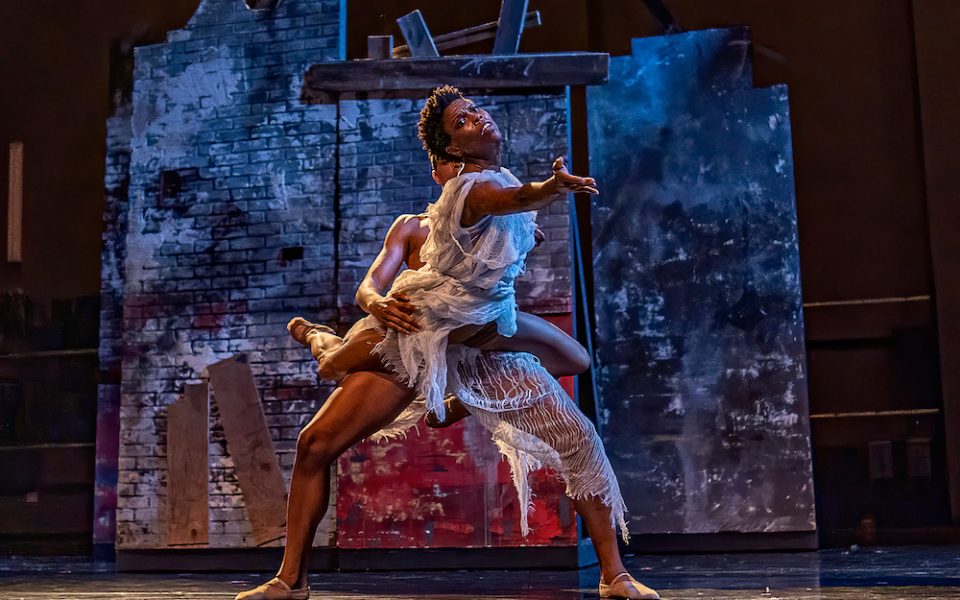Four dancers stomp simultaneously, shooting a reverb throughout the wooden panels beneath their feet. They mirror each movement as another group sprints out from behind painted brick walls. Each of the dancers in the front kicks out a leg to vault forward, the tattered white fabric wrapped around their bodies bouncing into the air as the backing track from the Tune-Yards repeats the chorus.
“No water in the water fountain,” the disembodied voice echoes, as the company congregates in three lines onstage.
A man tears through the crowd, kicking his knee up which catapults him into a spin. The song cuts as the group falls to the floor, limbs sprawled out in a tired collapse, ending a section titled “Hunger for Sustenance.”
The routine begins Heather Maloy’s Hunger, the headlining work that the Terpsicorps Theater of Dance brings to the Hanesbrands Theatre in Winston-Salem. The longform dance piece — divided into a dozen sections all with their own subtitles — spotlights hunger in its many forms. Though some parts explore more abstract ideas, Maloy challenges audiences to contextualize their own hunger, and remember their most basic needs.
The work arose as Maloy educated herself on the issue of food insecurity in North Carolina.
“It so much surpasses what I think anyone really realizes,” she says.
Through a partnership with Second Harvest Food Bank of Northwest NC during her troupe’s Winston-Salem stop, and MANNA FoodBank in Asheville, Maloy hopes to bring attention to the topic using her own training. Beth Bealle, a member of the fundraising team with Second Harvest Food Bank, reads out statistics gathered from the organization that places the number of food insecure people in the region at one in seven people.
During a section called “Hunger for Love,” a woman rushes around the few men who step out of a line of people that circles her in slow, steady steps. She jumps into the arms of one, who quickly spins her and lowers her to her knees. Even as she attempts to wrap her arms around his legs, he rejoins the group, leaving her alone. Another man steps out, first promising her a lover’s dance, but he soon grabs her wrists, puppeteering her limbs. Her face contorts in pain.
Maloy explains that using what she describes as “dance theater” provides a clear narrative to make audiences consider the abstract concepts more closely.
“That makes you sort of contemplate that thought of, Well I really hunger for love. But what if I didn’t even have food? Would I even have time to hunger for love?” she says, “If I would do these things to find love, what would I do to try and feed my family?”

As the dancer looking for love circles yet another man returning to the crowd, Lydia McRae steps in behind her. She gently touches the woman’s arm, facing the audience. The music slows to an end, and McRae gives her a gentle smile as their hands meet.
McRae, a member of Terpsicorps from Kernersville who studied at UNCSA, says details like the look on her face help convey the theatrics in Maloy’s choreography. She refers to her onstage self as a character, prioritizing her role as an actress as much as a dancer.
“You really have to make sure your characters come across not only in your dancing with your legs and your arms,” she says, “but your facial expression has to be on point all the time.”
One moment, “Hunger for More,” transforms ballet and contemporary dance into comedic tools to portray both greed and ambition. A flurry of light-up bouncy balls ricochet around the stage, as dancers struggle with one another to gather the most. A man walks onstage on his hands, his legs straight up in the air with a ball between his calves. A woman claps two together as she saunters downstage, letting the noise of the impact guide her beat.
Another man walks onto the stage, his hands tucked into his armpits, and he bobs his head back and forth like a chicken. He stops facing the audience, and relaxes his legs, a ball falling from between his legs like an egg.
“You can make a bold statement,” Maloy says, “and still have people laugh about it.”
Find out more about the theater group on their website here.
Join the First Amendment Society, a membership that goes directly to funding TCB‘s newsroom.
We believe that reporting can save the world.
The TCB First Amendment Society recognizes the vital role of a free, unfettered press with a bundling of local experiences designed to build community, and unique engagements with our newsroom that will help you understand, and shape, local journalism’s critical role in uplifting the people in our cities.
All revenue goes directly into the newsroom as reporters’ salaries and freelance commissions.


Leave a Reply